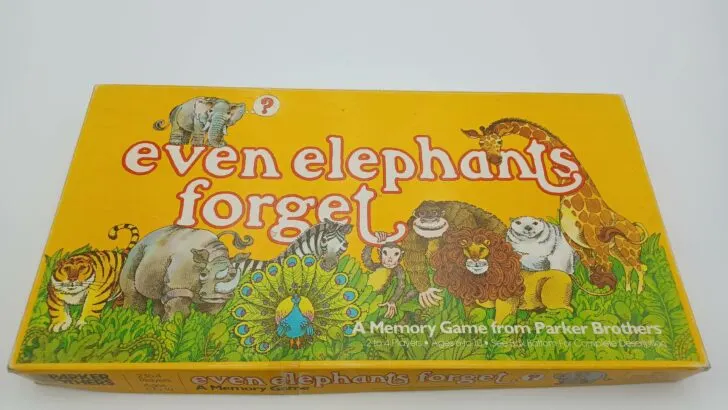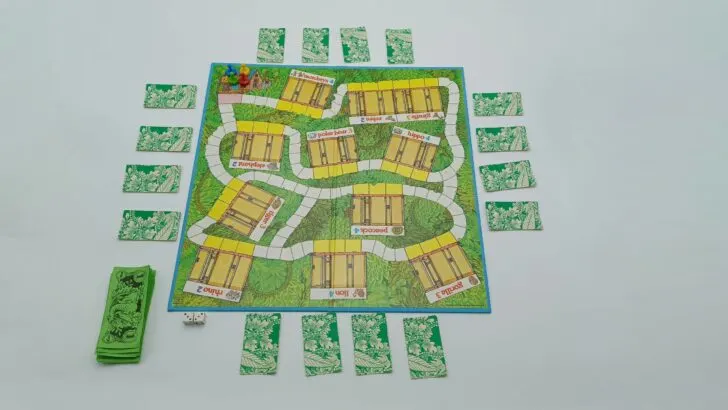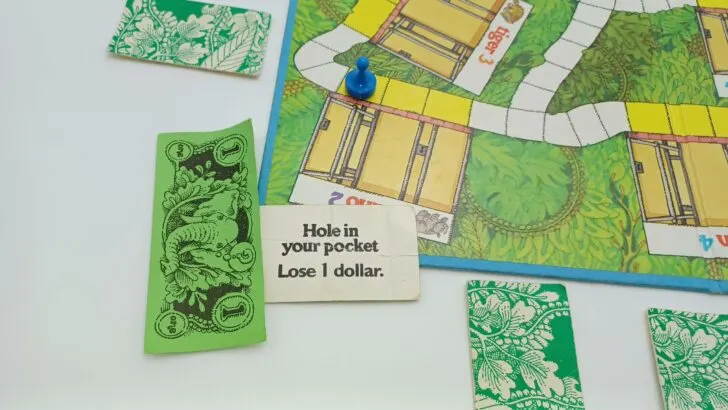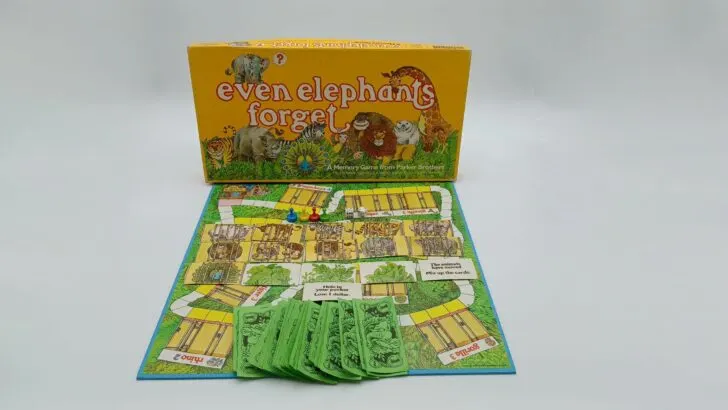Even Elephants Forget How to Play Quick Links: Objective | Setup | Playing the Game | Rolling and Moving | Searching for Animals | Winning the Game | FAQ | Components
Objective of Even Elephants Forget
The objective of Even Elephants Forget is to use your memory to return the escaped zoo animals to their cages and earn the most money when the game ends (when all animals are back in their cages).
Setup
Shuffle the cards up and place them around the outside of the board face down. Make sure that nobody sees which cards are placed where. Pick a player to be the zookeeper. They will act as the “banker” and will hand out reward money when players find animals and return them to their cages. All players choose a playing piece and place their token on the zookeeper’s house space (the start space). To determine the starting player, each player rolls the dice with the highest roller going first. Play then moves to the player’s left for the rest of the game.
Playing Even Elephants Forget
Rolling and Moving
Each player’s turn starts with them rolling the dice and moving that amount of spaces. Players may choose whether to roll one die or both dice, depending on if they need a small number or a larger one to get to a yellow space. Players may also move either forwards or backwards, but never both directions in the same turn (for example, if you roll a six you can’t move five spaces forward then go backwards one space). The goal is to land on one of the three yellow spaces by each cage as those are the only spots that allow you to look at a card to search for a missing animal.
White Spaces
If you land on a white space, your turn is over. You do not get to look at a card.
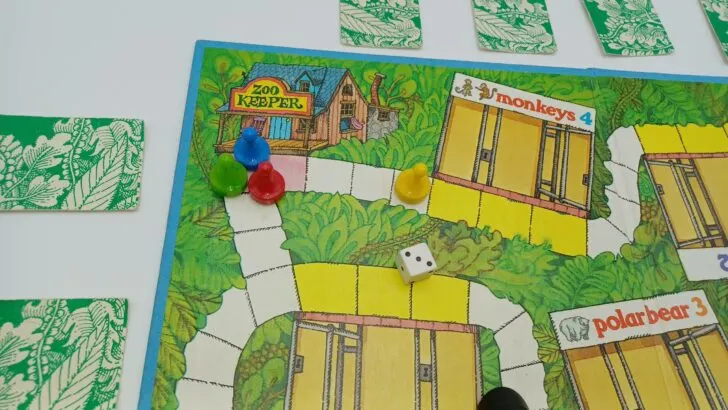
The yellow player has elected to roll just one die and rolled a three. They have landed on a white space, which ends their turn.
Yellow Spaces and Searching for Animals
If a player lands on a yellow space they get a chance to look at one of the cards that are face down around the board, but only if the cage next to the space is empty (if the animal that belongs there is already in its cage, they don’t get to look at a card). The goal is to find the animal card that matches the cage space that you are on so if you remember where that card is, be sure to select that card. Pick a card and turn it face up for everyone to see.
Wrong Animal
If you found an animal card but it doesn’t match the cage space you are on (like the photo below), return the card to the location you picked it from and place it face down. Your turn is now over.
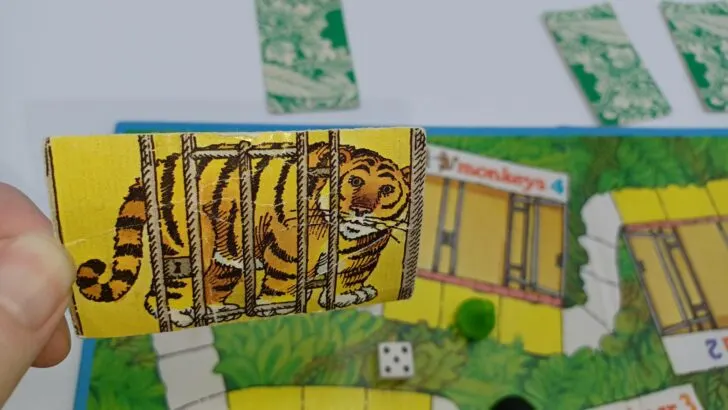
The green player also elected to roll just one die but were lucky enough to land on a yellow space, allowing them to select a card around the board. They were looking for the monkeys card but found the tiger card so no match was made. This card is then placed back face down where it was picked from.
Right Animal
If you picked the right animal card (it matches the cage spot you landed on), place the critter into its cage and collect your reward from the zookeeper. Your reward is equal to the amount posted on the cage’s sign ($2 for the rhino, elephant, and zebra, $3 for the giraffe, polar bear, tiger, and gorilla, and $4 for the lion, hippo, peacock, and monkeys). If you are able to return the last animal to its cage (the eleventh one), you also get a $2 bonus reward. After collecting your reward, your turn is over.
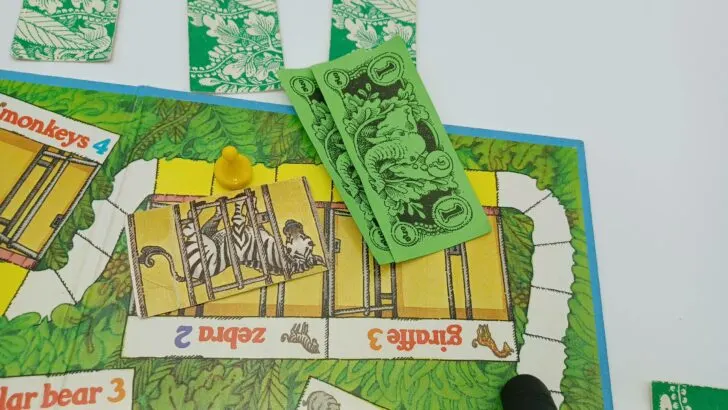
The yellow player landed on one of the yellow zebra cage spots and were able to successfully find the zebra card. They were awarded $2.
Foliage
If the card you select features foliage, return it to its spot and end your turn. The rules don’t outright say whether or not to place it back face down but there is a section that somewhat implies this later on.
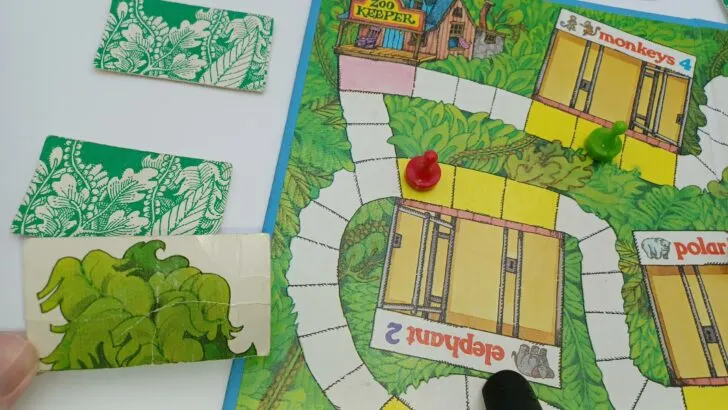
The red player selected a foliage card. They place the card back where it came from face down and their turn ends with nothing happening.
Hole in Your Pocket Card
There are also two special cards amongst the 16 zookeeper cards. The first is the “Hole in Your Pocket” card. If you are unlucky enough to select this card, you must give the zookeeper $1 if you’ve already received reward money (to the “bank money,” not to the zookeeper player’s own funds). If you don’t have any reward money, there is no penalty outside of effectively losing your turn. Return the card face down to the same spot you selected it from and end your turn.
The Animals Have Moved Card
The second special card is the “The Animals Have Moved” card. If a player selects this card, they gather all of the cards still surrounding the board (any animal cards in their cages stay there), reshuffle them, and place them face down around the board again without anyone seeing the cards. Then make sure to remove “The Animals Have Moved” card from play for the rest of the game.
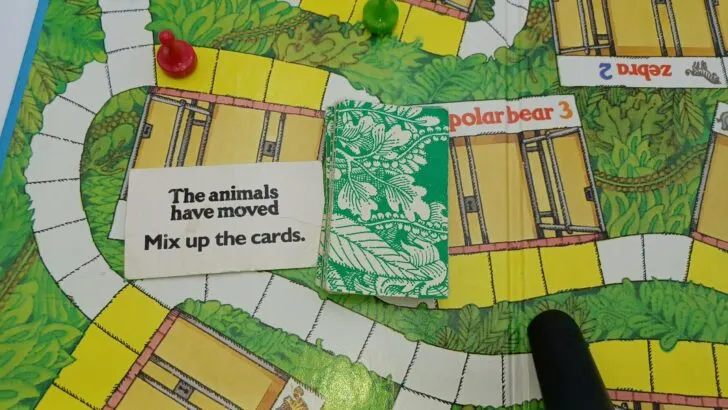
This player selected “The Animals Have Moved” card and has taken all of the cards still around the board and reshuffled them again. They will place them back face down around the board. Then remove this card from play for the rest of the game.
End of Turn
No matter which card you selected or whether or not you successfully captured an animal, your turn ends. Play continues to the left of the previous player.
Winning Even Elephants Forget
Even Elephants Forget ends when all animals have been returned to their cages. The player that returned the last animal receives a $2 bonus (in addition to whatever the animal was worth in the first place). All players count up their reward money and the player with the most money wins Even Elephants Forget.
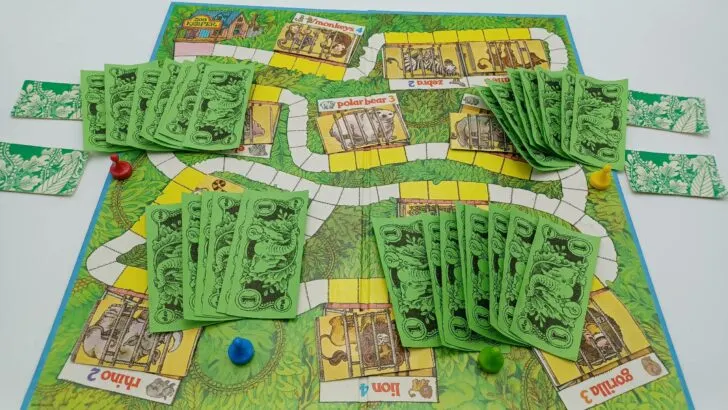
All animals have been returned to their cages and the game is over. The player to return the last animal to their cage receives a $2 bonus in addition to the amount the animal was worth. The players have tallied up their reward money and while it’s hard to see, the yellow player has $9, the green player $8, the red player $7, and the blue player only has $6. The yellow player has the most money and wins the game.
Even Elephants Forget FAQ
Do foliage cards stay face up or do you flip them face down?
The rules don’t explicitly state either way though there is a passage later in the rules that I would say implies that they are flipped face down. This passage is “Do you see why you should remember which cards have been turned over? When you do, you can avoid the wrong animal cards, the special cards, and the foliage cards.” This is more or less confirmation that they should flip face down.
Movement FAQs
Can you land on the same space as another player?
The game doesn’t say so you’ll have to house rule this. I usually allow landing on the same space as long as the rules don’t outright say you can’t.
Can you stay on the same set of three yellow spaces (the same cage) if you happen to roll a one or two?
Again, the rules unfortunately do not mention this at all so you’ll have to make the decision yourself. I personally think it’s a legal move though. Just make sure you don’t move both forwards and backwards in the same turn.
Are you allowed to land on a yellow space if the animal that belongs in that cage has already been found?
Presumably yes (this is another thing not mentioned in the rules), however you are not allowed to search for an animal card as the rules explicitly say you need to land on a yellow space “outside an empty cage.”
Can you move through the red start space?/Does it count as a space?
Remember that you can move either forwards or backwards so presumably you can move through the red start space if you want to head towards that section of the board. That’s how I played it and I counted it as a space when moving through it. You’ll have to house rule this as well. I personally see no reason why you can’t move through it.
Note: If you have any questions about how to play Even Elephants Forget, leave a comment below on this post. I will try to answer any questions asked as best and as quickly as possible.
Components
- Game board
- 4 playing pieces (green, yellow, blue, and red)
- 2 six-sided dice
- Play money
- 16 zookeeping cards (11 animals, 3 foliage, and 2 special cards with instructions)
- Instructions
Year: 1981 | Publisher: Parker Brothers
Genres: Memory, Roll and Move, Children’s, Family
Ages: 6-10 | Number of Players: 2-4 | Length of Game: 30 minutes
Difficulty: Light | Strategy: Light | Luck: Moderate
Where to Purchase: eBay, Any purchases made through these links (including other products) help keep Geeky Hobbies running. Thank you for your support.

